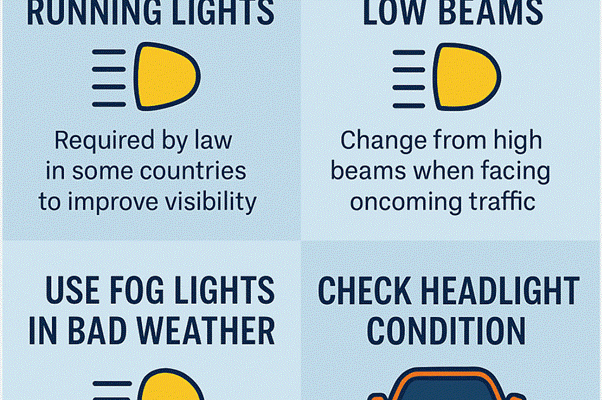As winter approaches, many drivers find themselves navigating through fog, rain, and snow․ These challenging driving conditions can significantly impair visibility, making it crucial to equip your vehicle with the right tools for safety․ One of the often-overlooked features in vehicle lighting is the fog light․ This article delves into the functionality of fog lights, their importance in ensuring safety on the road, and how to use them effectively․
What Are Fog Lights?
Fog lights are specialized automotive lights designed to illuminate the road immediately in front of a vehicle in low-visibility conditions such as fog, rain, or snow․ Unlike standard headlights, which are aimed at a higher angle to cast light further down the road, fog lights emit a wide, short beam of light that is aimed low to the ground․ This design helps reduce the amount of light that is reflected back into the driver’s eyes by the fog, rain, or snow, allowing for better visibility․
The Functionality of Fog Lights
Fog lights serve several important functions:
- Enhanced Visibility: Fog lights illuminate the road close to the vehicle, helping drivers see obstacles, road markings, and other vehicles in low visibility conditions․
- Reduced Glare: By positioning the lights low and wide, fog lights minimize glare that can occur when using high beams in foggy or snowy conditions․
- Increased Awareness: Fog lights also make vehicles more visible to other drivers, which is particularly important in adverse weather conditions․
Why Are Fog Lights Important for Vehicle Safety?
The importance of fog lights in vehicle safety cannot be overstated․ Here are several reasons why:
1․ Improving Reaction Time
In poor visibility conditions, the ability to see and react to road hazards is critical․ Fog lights provide a clearer view of the road ahead, allowing drivers to spot potential dangers such as potholes, pedestrians, or animals crossing the road, giving them precious seconds to react․
2․ Reducing Accidents
Statistics show that many accidents occur during adverse weather conditions when visibility is low․ By using fog lights, drivers can significantly reduce the risk of collisions by ensuring they can see and be seen․ This simple enhancement to vehicle lighting can be a lifesaver․
3․ Legal Requirements
In some regions, using fog lights during specific weather conditions is not just a safety measure but a legal requirement․ Understanding local laws regarding fog light usage can help drivers avoid fines and contribute to overall road safety․
How to Use Fog Lights Effectively
To maximize the benefits of fog lights, drivers should be aware of how and when to use them:
- When to Use: Fog lights should be used in fog, heavy rain, or snowfall․ They are not intended for use in clear weather, as they can cause glare for other drivers․
- Know When to Turn Them Off: Once visibility improves, drivers should switch off their fog lights to avoid blinding other road users․
- Proper Positioning: Ensure fog lights are correctly positioned on your vehicle․ Misaligned lights can reduce effectiveness and create hazards for others․










Great insights on fog lights! I had no idea they were designed to reduce glare. This will definitely change how I drive in foggy conditions.
Fantastic article! I learned so much about how fog lights work and why they
I appreciate how clearly the article explains the functionality of fog lights. It
I loved this read! It
This article is super informative! The section on improving reaction time with fog lights is especially helpful. Thanks for sharing!
This article really opened my eyes to the importance of fog lights! I never realized how much they could enhance safety during winter driving.